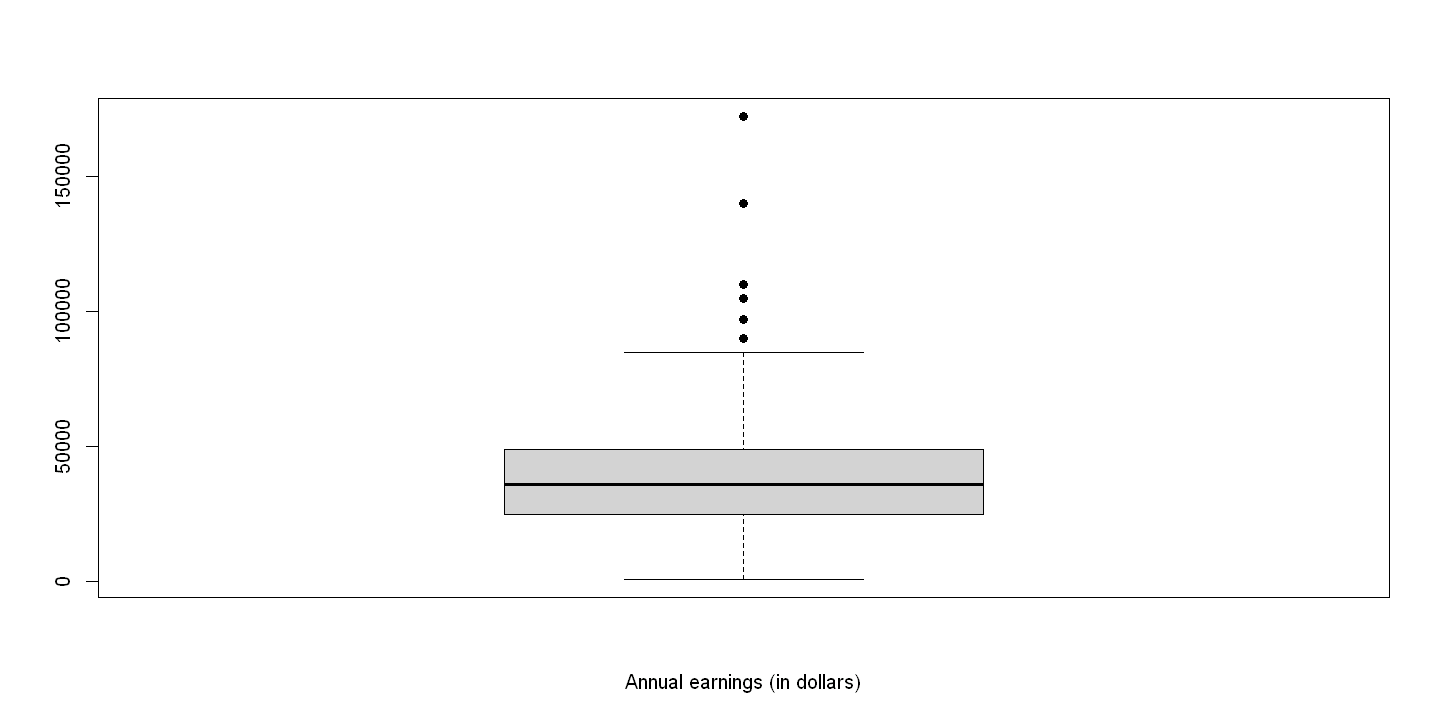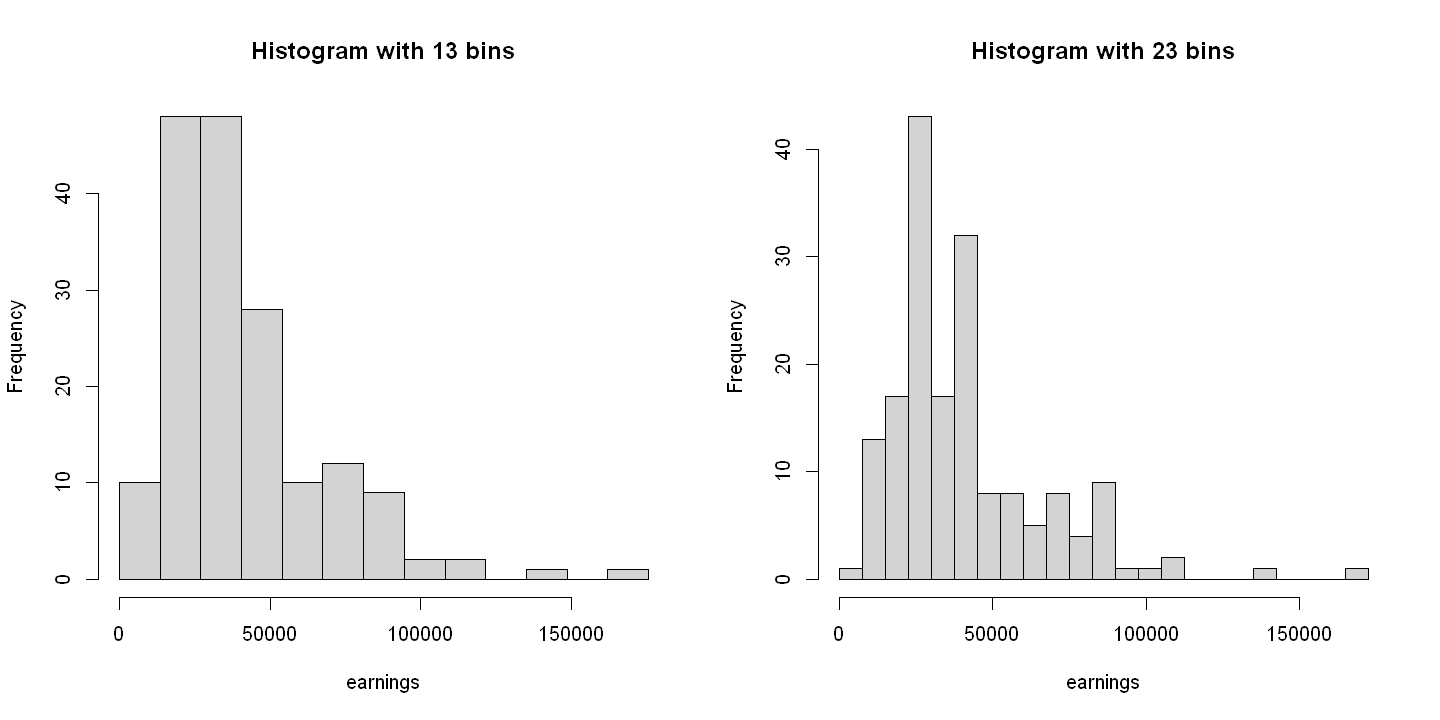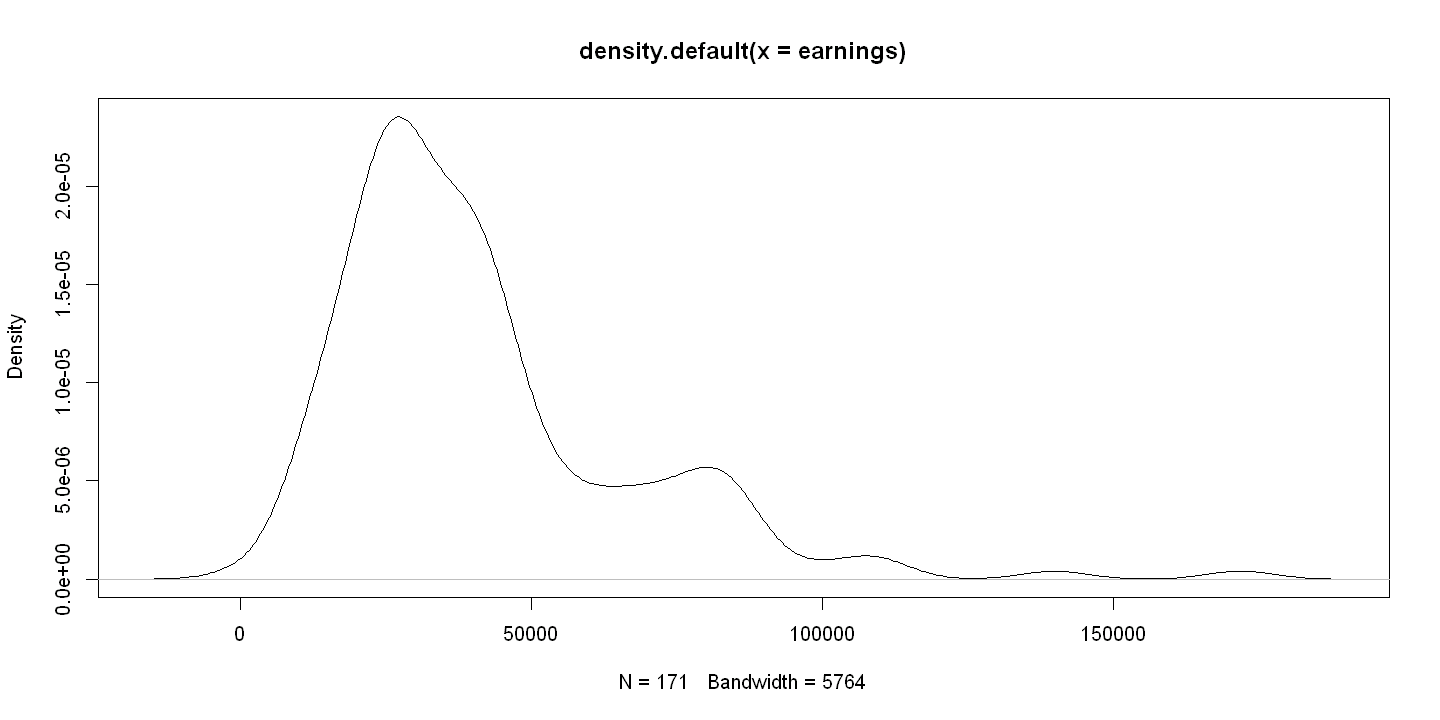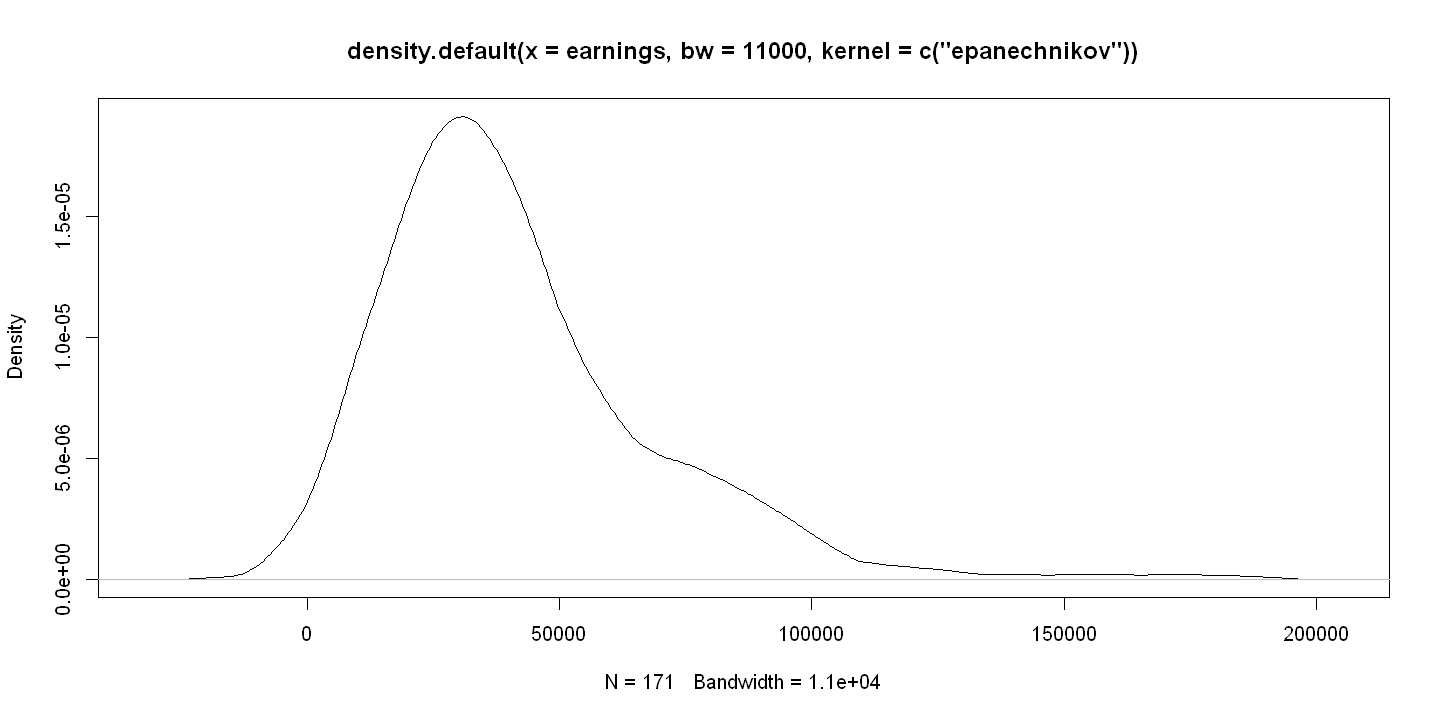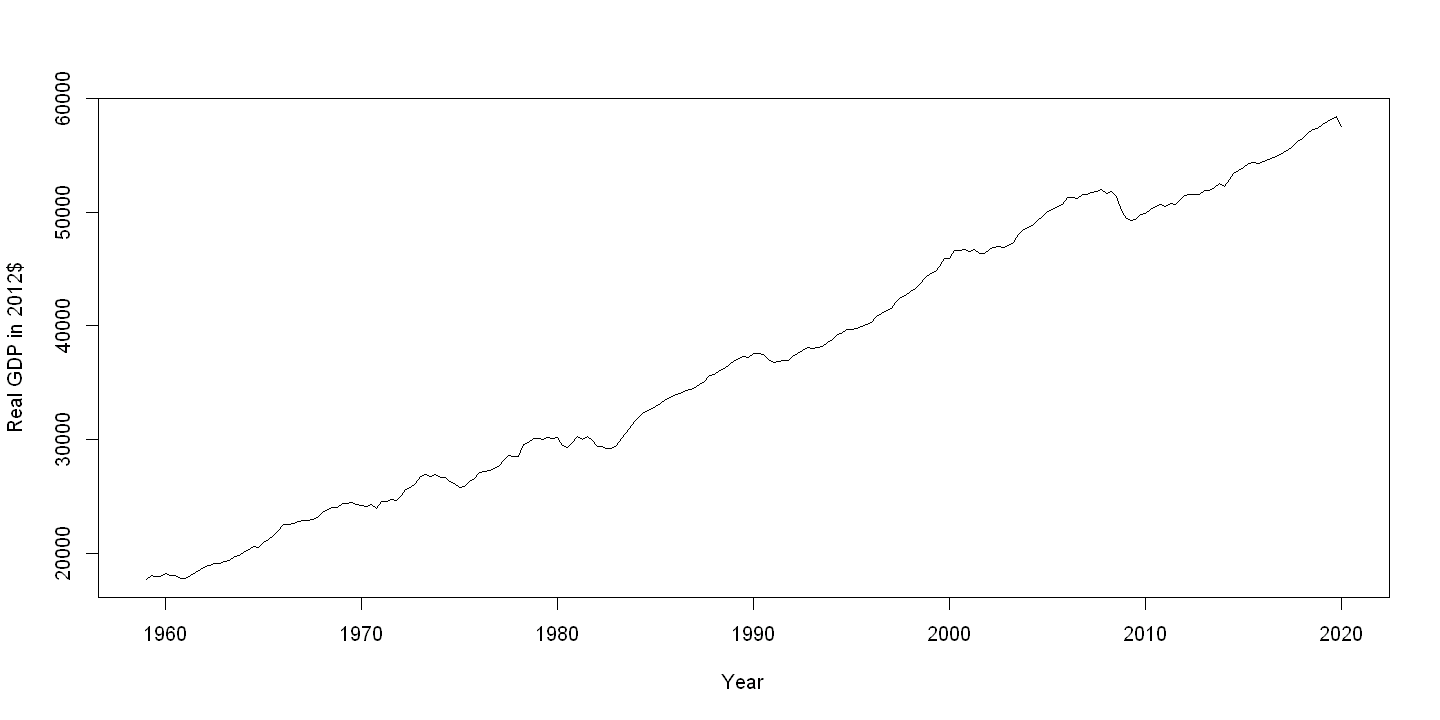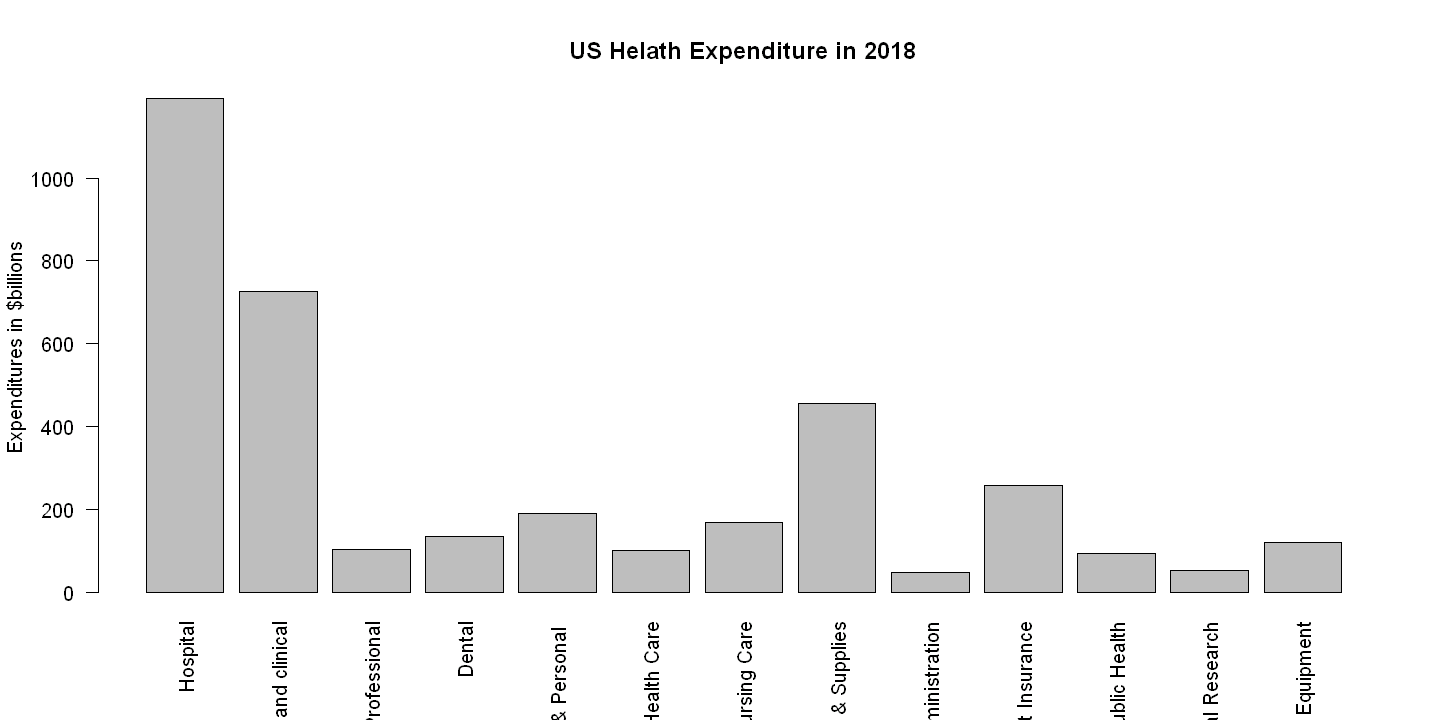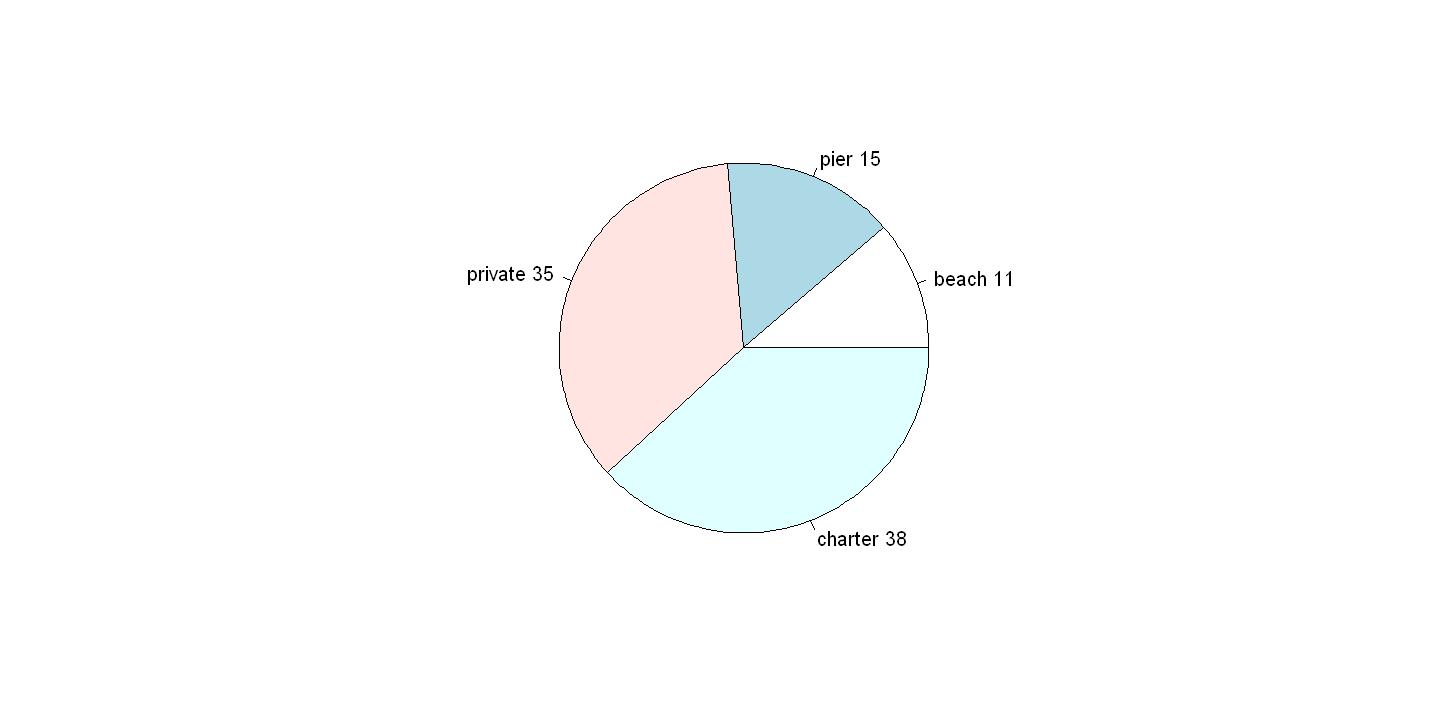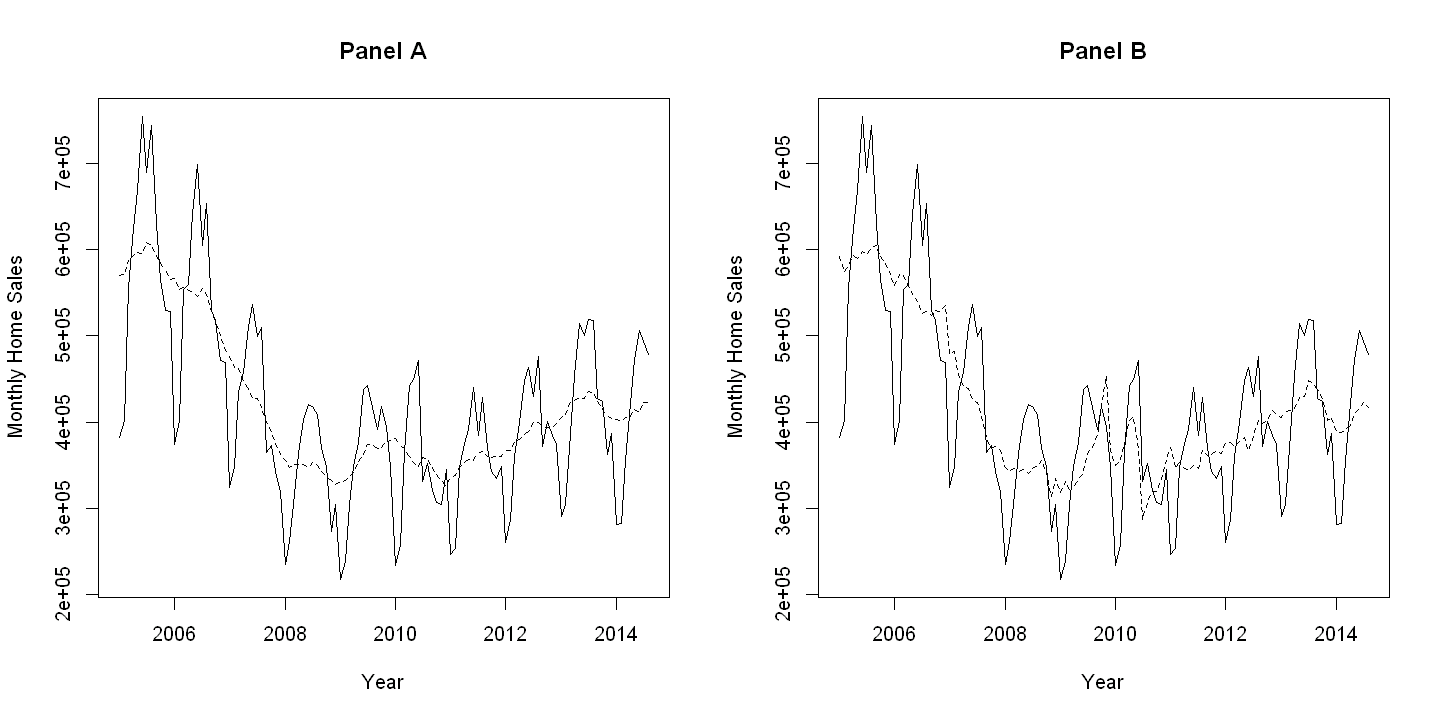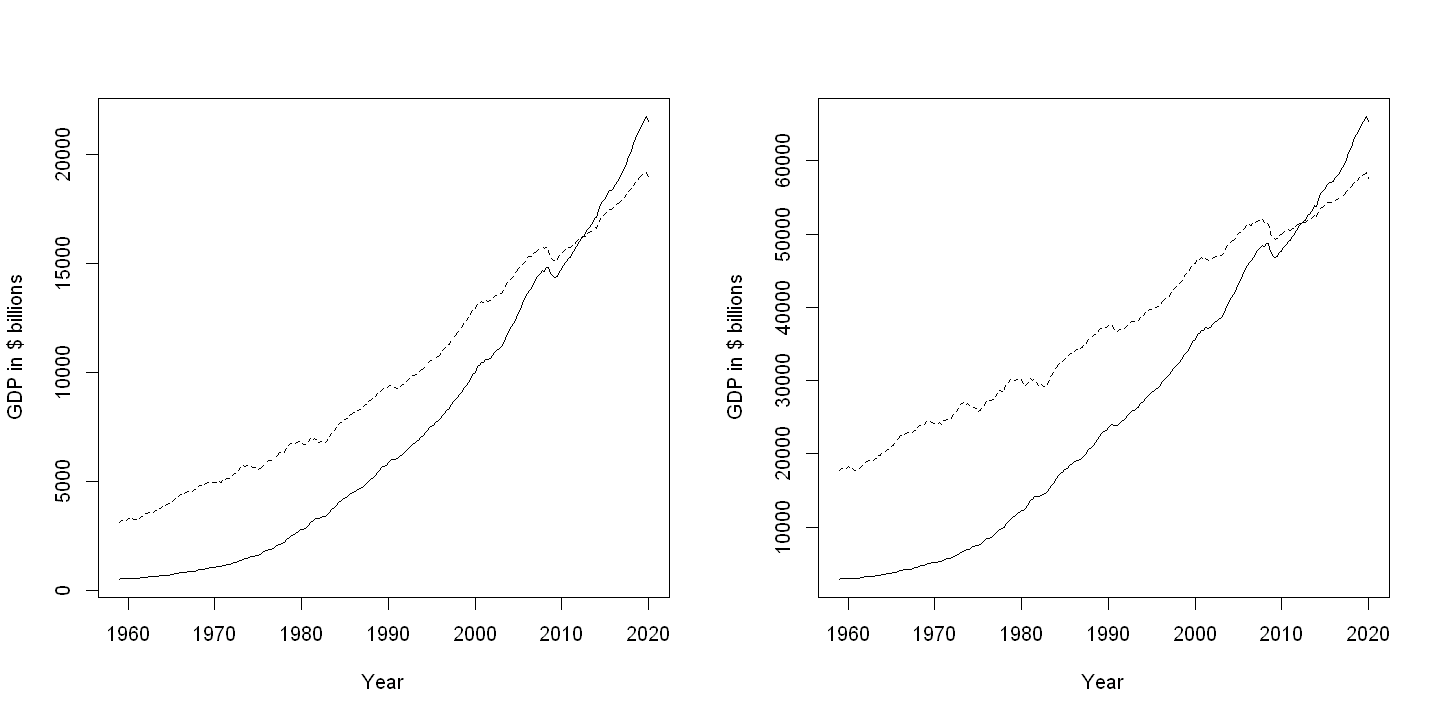2. CHAPTER 2. UNIVARIATE DATA SUMMARY#
Set up
library(foreign) # to open stata.dta files
library(psych) # for better sammary of descriptive statistics
library(repr) # to combine graphs with adjustable plot dimensions
options(repr.plot.width = 12, repr.plot.height = 6) # Plot dimensions (in inches)
options(width = 150) # To increase character width of printed output
2.1. 2.1 SUMMARY STATISTICS FOR NUMERICAL DATA#
rm(list=ls())
df = read.dta(file = "Dataset/AED_EARNINGS.DTA")
print(describe(df))
vars n mean sd median trimmed mad min max range skew kurtosis se
earnings 1 171 41412.69 25527.05 36000 38052.70 17049.90 1050 172000 170950 1.70 4.23 1952.10
education 2 171 14.43 2.74 14 14.45 2.97 3 20 17 -0.45 1.16 0.21
age 3 171 30.00 0.00 30 30.00 0.00 30 30 0 NaN NaN 0.00
gender 4 171 0.00 0.00 0 0.00 0.00 0 0 0 NaN NaN 0.00
2.1.1. Table 2.1#
print(describe(df$earnings))
vars n mean sd median trimmed mad min max range skew kurtosis se
X1 1 171 41412.69 25527.05 36000 38052.7 17049.9 1050 172000 170950 1.7 4.23 1952.1
quantile(df$earnings)
- 0%
- 1050
- 25%
- 25000
- 50%
- 36000
- 75%
- 49000
- 100%
- 172000
mean(df$earnings)
41412.6900584795
Skewness and kurtosis require moments package
attach(df) # Allow variables in database to be accessed simply by giving names
library(moments)
skewness(earnings) #Note no need to write "df$..." now since we've attached the data.
kurtosis(earnings)
1.71255481120525
7.3163879423401
2.1.2. Figure 2.2#
2.2. 2.2 CHARTS FOR NUMERICAL DATA#
2.2.1. Table 2.2#
print(describe(earnings))
vars n mean sd median trimmed mad min max range skew kurtosis se
X1 1 171 41412.69 25527.05 36000 38052.7 17049.9 1050 172000 170950 1.7 4.23 1952.1
# Define bins
bins <- cut(earnings, breaks = seq(0, 180000, by = 15000), right = FALSE)
# Frequency table
freq <- table(bins)
# Relative frequency (%)
rel_freq <- prop.table(freq) * 100
# Combine
result <- data.frame(
Range = names(freq),
Frequency = as.numeric(freq),
`Relative Frequency (%)` = round(as.numeric(rel_freq), 2)
)
print(result)
Range Frequency Relative.Frequency....
1 [0,1.5e+04) 12 7.02
2 [1.5e+04,3e+04) 53 30.99
3 [3e+04,4.5e+04) 52 30.41
4 [4.5e+04,6e+04) 20 11.70
5 [6e+04,7.5e+04) 11 6.43
6 [7.5e+04,9e+04) 16 9.36
7 [9e+04,1.05e+05) 2 1.17
8 [1.05e+05,1.2e+05) 3 1.75
9 [1.2e+05,1.35e+05) 0 0.00
10 [1.35e+05,1.5e+05) 1 0.58
11 [1.5e+05,1.65e+05) 0 0.00
12 [1.65e+05,1.8e+05) 1 0.58
2.2.2. Figure 2.4#
2.2.3. Figure 2.5#
2.2.4. Figure 2.6#
(New dataset)
rm(list=ls())
df = read.dta(file = "Dataset/AED_REALGDPPC.DTA")
#df<-na.omit(df)
print(describe(df))
Warning message in FUN(newX[, i], ...):
"no non-missing arguments to min; returning Inf"
Warning message in FUN(newX[, i], ...):
"no non-missing arguments to max; returning -Inf"
vars n mean sd median trimmed mad min max range skew kurtosis se
gdpc1 1 245 9925.24 4814.02 9238.92 9716.91 6140.55 3121.94 19221.97 16100.03 0.32 -1.25 307.56
gdp 2 245 7401.46 6331.00 5695.36 6755.00 6885.44 510.33 21729.12 21218.79 0.65 -0.88 404.47
gdpdef 3 245 59.72 31.20 61.65 59.06 44.57 16.35 113.50 97.16 0.03 -1.36 1.99
date* 4 245 123.00 70.87 123.00 123.00 90.44 1.00 245.00 244.00 0.00 -1.21 4.53
daten 5 245 NaN NA NA NaN NA Inf -Inf -Inf NA NA NA
quarter 6 245 118.00 70.87 118.00 118.00 90.44 -4.00 240.00 244.00 0.00 -1.21 4.53
popthm 7 245 253116.88 45611.79 247695.00 252742.75 58854.77 176044.00 329527.00 153483.00 0.10 -1.28 2914.03
year 8 245 1989.13 17.72 1989.00 1989.13 22.24 1959.00 2020.00 61.00 0.00 -1.21 1.13
realgdp 9 245 9925.24 4814.03 9238.97 9716.90 6140.78 3121.86 19222.00 16100.14 0.32 -1.25 307.56
gdppc 10 245 25841.47 19184.69 22993.15 24423.21 24740.38 2898.86 66008.59 63109.73 0.44 -1.13 1225.66
realgdppc 11 245 37050.50 12089.68 36929.01 36996.63 16507.15 17733.26 58392.45 40659.20 0.08 -1.33 772.38
growth 12 241 1.99 2.18 2.09 2.08 1.80 -4.77 7.63 12.40 -0.38 0.64 0.14
2.3. 2.3 CHARTS FOR NUMERICAL DATA BY CATEGORY#
2.3.1. Figure 2.7#
Uses new data
rm(list=ls())
df = read.dta(file = "Dataset/AED_HEALTHCATEGORIES.DTA")
print(describe(df))
vars n mean sd median trimmed mad min max range skew kurtosis se
category* 1 13 7.0 3.89 7 7.00 4.45 1 13 12 0.00 -1.48 1.08
expenditures 2 13 281.0 332.97 136 219.36 83.03 48 1192 1144 1.66 1.63 92.35
cat_short* 3 13 3.0 2.00 3 2.82 2.97 1 7 6 0.63 -0.98 0.55
exp_short 4 4 539.5 520.58 431 539.50 461.09 104 1192 1088 0.24 -2.17 260.29
2.3.2. Table 2.3#
attach(df)
df[, c("category","expenditures")]
| category | expenditures | |
|---|---|---|
| <chr> | <int> | |
| 1 | Hospital | 1192 |
| 2 | Physician and clinical | 726 |
| 3 | Other Professional | 104 |
| 4 | Dental | 136 |
| 5 | Other Health & Personal | 192 |
| 6 | Home Health Care | 102 |
| 7 | Nursing Care | 169 |
| 8 | Drugs & Supplies | 456 |
| 9 | Govt. Administration | 48 |
| 10 | Net Cost Insurance | 259 |
| 11 | Govt. Public Health | 94 |
| 12 | Noncommercial Research | 53 |
| 13 | Structures & Equipment | 122 |
2.3.3. Figure 2.7#
2.4. 2.4 SUMMARY AND CHARTS FOR CATEGORICAL DATA#
2.4.1. Table 2.4#
rm(list=ls())
df = read.dta(file = "Dataset/AED_FISHING.DTA")
attach(df)
print(describe(df))
vars n mean sd median trimmed mad min max range skew kurtosis se
mode* 1 1182 3.01 0.99 3.00 3.13 1.48 1.00 4.00 3.00 -0.70 -0.58 0.03
price 2 1182 52.08 53.83 37.90 42.52 35.13 1.29 666.11 664.82 3.14 19.19 1.57
crate 3 1182 0.39 0.56 0.16 0.26 0.23 0.00 2.31 2.31 2.35 5.23 0.02
dbeach 4 1182 0.11 0.32 0.00 0.02 0.00 0.00 1.00 1.00 2.44 3.94 0.01
dpier 5 1182 0.15 0.36 0.00 0.06 0.00 0.00 1.00 1.00 1.95 1.81 0.01
dprivate 6 1182 0.35 0.48 0.00 0.32 0.00 0.00 1.00 1.00 0.61 -1.63 0.01
dcharter 7 1182 0.38 0.49 0.00 0.35 0.00 0.00 1.00 1.00 0.48 -1.77 0.01
pbeach 8 1182 103.42 103.64 74.63 85.99 78.33 1.29 843.19 841.90 1.87 4.97 3.01
ppier 9 1182 103.42 103.64 74.63 85.99 78.33 1.29 843.19 841.90 1.87 4.97 3.01
pprivate 10 1182 55.26 62.71 33.53 43.05 34.45 2.29 666.11 663.82 2.65 12.26 1.82
pcharter 11 1182 84.38 63.54 61.61 72.35 35.45 27.29 691.11 663.82 2.59 11.64 1.85
qbeach 12 1182 0.24 0.19 0.25 0.23 0.28 0.07 0.53 0.47 0.63 -1.24 0.01
qpier 13 1182 0.16 0.16 0.08 0.15 0.11 0.00 0.45 0.45 1.07 -0.47 0.00
qprivate 14 1182 0.17 0.21 0.09 0.13 0.11 0.00 0.74 0.74 1.67 1.73 0.01
qcharter 15 1182 0.63 0.71 0.42 0.50 0.59 0.00 2.31 2.31 1.36 0.91 0.02
income 16 1182 4.10 2.46 3.75 3.81 2.47 0.42 12.50 12.08 1.30 2.09 0.07
one 17 1182 1.00 0.00 1.00 1.00 0.00 1.00 1.00 0.00 NaN NaN 0.00
freq = table(mode)
relfreq = table(mode) / nrow(df)
relfreq
cbind(freq,relfreq)
mode
beach pier private charter
0.1133672 0.1505922 0.3536379 0.3824027
| freq | relfreq | |
|---|---|---|
| beach | 134 | 0.1133672 |
| pier | 178 | 0.1505922 |
| private | 418 | 0.3536379 |
| charter | 452 | 0.3824027 |
2.4.2. Figure 2.9#
2.5. 2.5 DATA TRANSFORMATION#
2.5.1. Figure 2.10#
rm(list=ls())
df = read.dta(file = "Dataset/AED_EARNINGS.DTA")
print(describe(df))
lnearns = log(earnings)
# Following combines into one graph
par(mfrow=c(1,2))
hist(earnings)
hist(lnearns)
par(mfrow=c(1,1))
vars n mean sd median trimmed mad min max range skew kurtosis se
earnings 1 171 41412.69 25527.05 36000 38052.70 17049.90 1050 172000 170950 1.70 4.23 1952.10
education 2 171 14.43 2.74 14 14.45 2.97 3 20 17 -0.45 1.16 0.21
age 3 171 30.00 0.00 30 30.00 0.00 30 30 0 NaN NaN 0.00
gender 4 171 0.00 0.00 0 0.00 0.00 0 0 0 NaN NaN 0.00
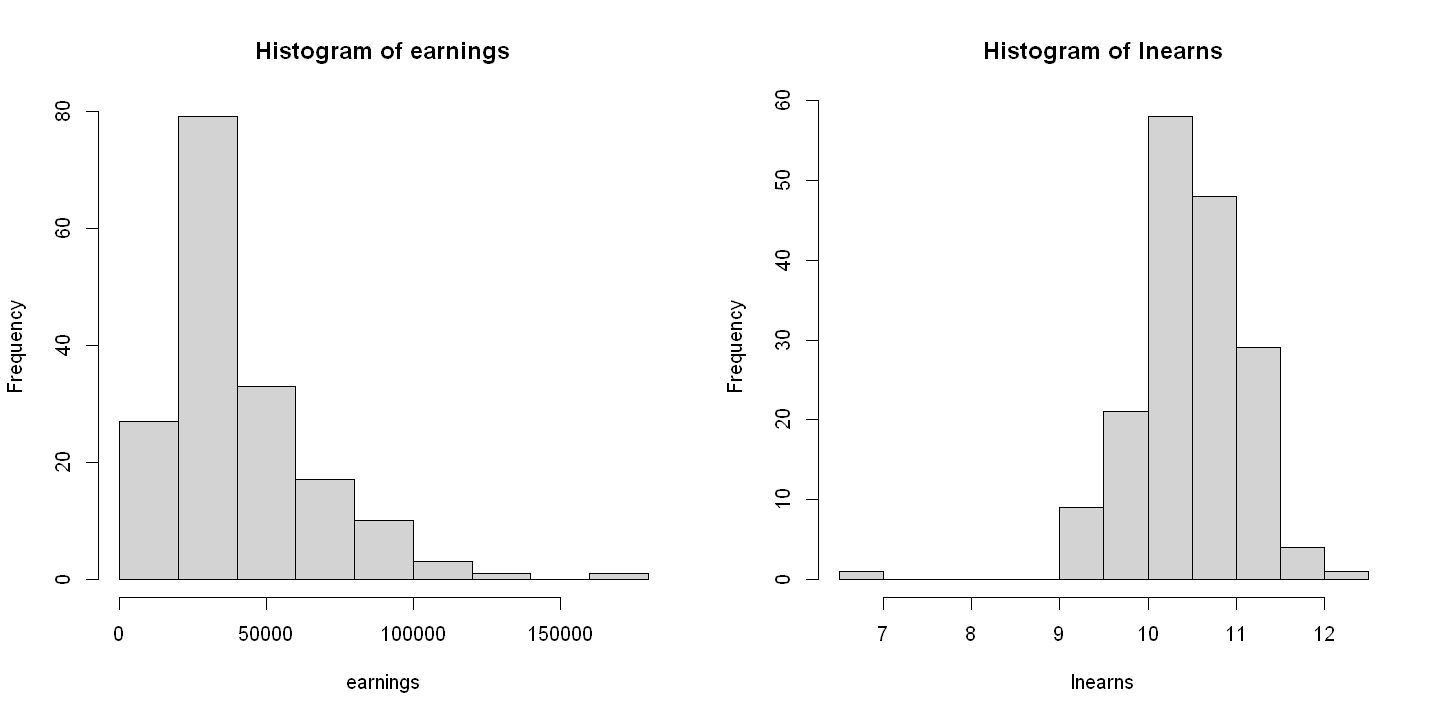
2.6. 2.6 DATA TRANSFORMATIONS FOR TIME SERIES DATA#
2.6.1. Figure 2.11#
rm(list=ls())
df = read.dta(file = "Dataset/AED_MONTHLYHOMESALES.DTA")
df<-na.omit(df)
print(describe(df))
Warning message in FUN(newX[, i], ...):
"no non-missing arguments to min; returning Inf"
Warning message in FUN(newX[, i], ...):
"no non-missing arguments to max; returning -Inf"
vars n mean sd median trimmed mad min max range skew kurtosis se
date* 1 183 92.00 52.97 92.00 92.00 68.20 1.00 183.0 182.00 0.00 -1.22 3.92
daten 2 183 NaN NA NA NaN NA Inf -Inf -Inf NA NA NA
year 3 183 2006.54 4.43 2007.00 2006.54 5.93 1999.00 2014.0 15.00 0.00 -1.20 0.33
month 4 183 564.00 52.97 564.00 564.00 68.20 473.00 655.0 182.00 0.00 -1.22 3.92
exsales 5 183 441896.17 112222.28 430000.00 436442.18 120090.60 218000.00 754000.0 536000.00 0.42 -0.20 8295.71
exsales_sa 6 183 440405.28 79738.96 429166.66 436553.29 87720.53 287500.00 605000.0 317500.00 0.40 -0.85 5894.47
exsales_ma11 7 183 440587.18 77367.04 429818.19 435697.59 83025.60 324818.19 608545.4 283727.25 0.50 -0.84 5719.14
construct 8 183 77758.60 13800.18 76605.00 77087.00 13432.36 50590.00 110434.0 59844.00 0.40 -0.44 1020.14
construct_sa 9 183 77654.14 10938.52 73654.41 76862.75 9539.67 61597.25 101105.8 39508.59 0.61 -0.94 808.60
newdata <- df[which(df$year>=2005),]
attach(newdata)
print(describe(newdata))
Warning message in FUN(newX[, i], ...):
"no non-missing arguments to min; returning Inf"
Warning message in FUN(newX[, i], ...):
"no non-missing arguments to max; returning -Inf"
vars n mean sd median trimmed mad min max range skew kurtosis se
date* 1 116 58.50 33.63 58.50 58.50 43.00 1.00 116.0 115.00 0.00 -1.23 3.12
daten 2 116 NaN NA NA NaN NA Inf -Inf -Inf NA NA NA
year 3 116 2009.34 2.81 2009.00 2009.34 2.97 2005.00 2014.0 9.00 0.02 -1.23 0.26
month 4 116 597.50 33.63 597.50 597.50 43.00 540.00 655.0 115.00 0.00 -1.23 3.12
exsales 5 116 418224.14 113429.85 400500.00 409329.79 99334.20 218000.00 754000.0 536000.00 0.75 0.39 10531.70
exsales_sa 6 116 418060.34 85092.86 393750.00 409326.24 66099.27 287500.00 605000.0 317500.00 0.91 -0.40 7900.67
exsales_ma11 7 116 418300.16 81757.24 394000.00 408255.32 56743.13 324818.19 608545.4 283727.25 1.05 -0.23 7590.97
construct 8 116 80910.13 14761.47 80222.00 80769.12 14440.52 50590.00 110434.0 59844.00 0.14 -0.76 1370.57
construct_sa 9 116 81005.70 11693.50 79465.54 80859.19 16730.90 62914.17 101105.8 38191.67 0.16 -1.46 1085.71
2.6.2. Figure 2.12#
rm(list=ls())
df = read.dta(file = "Dataset/AED_REALGDPPC.DTA")
attach(df)
print(describe(df))
The following objects are masked from newdata:
date, daten, year
Warning message in FUN(newX[, i], ...):
"no non-missing arguments to min; returning Inf"
Warning message in FUN(newX[, i], ...):
"no non-missing arguments to max; returning -Inf"
vars n mean sd median trimmed mad min max range skew kurtosis se
gdpc1 1 245 9925.24 4814.02 9238.92 9716.91 6140.55 3121.94 19221.97 16100.03 0.32 -1.25 307.56
gdp 2 245 7401.46 6331.00 5695.36 6755.00 6885.44 510.33 21729.12 21218.79 0.65 -0.88 404.47
gdpdef 3 245 59.72 31.20 61.65 59.06 44.57 16.35 113.50 97.16 0.03 -1.36 1.99
date* 4 245 123.00 70.87 123.00 123.00 90.44 1.00 245.00 244.00 0.00 -1.21 4.53
daten 5 245 NaN NA NA NaN NA Inf -Inf -Inf NA NA NA
quarter 6 245 118.00 70.87 118.00 118.00 90.44 -4.00 240.00 244.00 0.00 -1.21 4.53
popthm 7 245 253116.88 45611.79 247695.00 252742.75 58854.77 176044.00 329527.00 153483.00 0.10 -1.28 2914.03
year 8 245 1989.13 17.72 1989.00 1989.13 22.24 1959.00 2020.00 61.00 0.00 -1.21 1.13
realgdp 9 245 9925.24 4814.03 9238.97 9716.90 6140.78 3121.86 19222.00 16100.14 0.32 -1.25 307.56
gdppc 10 245 25841.47 19184.69 22993.15 24423.21 24740.38 2898.86 66008.59 63109.73 0.44 -1.13 1225.66
realgdppc 11 245 37050.50 12089.68 36929.01 36996.63 16507.15 17733.26 58392.45 40659.20 0.08 -1.33 772.38
growth 12 241 1.99 2.18 2.09 2.08 1.80 -4.77 7.63 12.40 -0.38 0.64 0.14
2.6.3. #
2.6.4. Table 2.5#
selected_cols <- c("date", "quarter", "gdp", "gdpdef", "realgdp")
first_row <- head(df[, selected_cols], n = 1)
last_row <- tail(df[, selected_cols], n = 1)
# Combine
result <- rbind(first_row, last_row)
print(result)
date quarter gdp gdpdef realgdp
1 1959-01-01 -4 510.33 16.347 3121.857
245 2020-01-01 240 21539.69 113.502 18977.365
